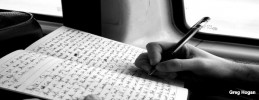As an undergraduate at Boise State University in the 1980s, I got hooked on the short stories of Ernest Hemingway. I liked his punchy, straight-forward style of writing, a style which seemed to me to be thoroughly honest and revealing. He had fallen out of favour, by then, as the women’s movement considered him to be a misogynist (a claim I strongly dispute), so being a female fan was quite a lonely business. Two of my fellow writing students, Richard Webb and Joe Ross, were also Hemingway buffs, and together we formed a writing workshop which we referred to by the grandiose moniker of ‘The Boise Writers Guild Troika’. Our workshops consisted primarily of drinking endless cups of coffee at all-night greasy spoons and dreams of exploring such seemingly exotic Hemingway haunts as Paris, Key West and the Serengeti. After our Troika imploded, Rick and I made a trip to Ketchum, Idaho in the foothills of the Sawtooth Mountains, where Hemingway spent most of his final years.
After repeated sessions of ECT to combat his increasing paranoia and depression destroyed his ability to write, Hemingway picked up the Chekhovian gun that had been waiting for him his entire life. It was an untidy ending, but one that was completely in character: suicide and death clouded his stories, as indeed they had clouded his family. People who followed his career in real time must have seen it coming, they must have known how his story would end. Hemingway believed in his own myth, and, no longer able to write that ‘one true sentence’, he brought his life to its final full stop.
In Ketchum, Rick and I paid homage to the great man, and had a picnic on his grave. Each of us hoped, I think, that a remnant of his power might filter up through the soil and through the granite slab covering his grave so that we could carry some of it home with us. I don’t know whatever happened to Rick or Joe, but I hope they’re still out there somewhere, still reading Hemingway and still striving, as I am striving, to write the truest sentences possible.
***
Style: Hemingway’s writing style is often described as being ‘spare’, ‘tightly-constructed’ or ‘lean’ and he is famous for the way he eschewed needless adjectives. On the page, his writing appears simplistic: short, declarative sentences; realistic imagery; and unadorned language. As a young journalist, he learned to cut away the excess, leaving only that which was absolutely necessary, and he carried this practice into his fiction. When Faulkner famously accused him of never having used a word that might send the reader to a dictionary, Hemingway shot back that he didn’t need to use big words to convey big emotions. And in fact, sometimes he didn’t need to use words at all. ‘Hills Like White Elephants’ is only one example of the way in which emotions which remain unstated can dominate a story.
In another literary argument, played out in the pages of Death in the Afternoon, Aldous Huxley bemoaned the contemporary trend for writers like Hemingway to ‘feign stupidity’ by hiding their knowledge. In his rebuttal, Hemingway set out his now famous ‘iceberg theory’ of writing fiction: ‘If a writer of prose knows enough about what he is writing about he may omit things that he knows and the reader, if the writer is writing truly enough, will have a feeling of those things as strongly as though the writer had stated them.’ It is this respect for reader that makes Hemingway’s writing so powerful: it allows the reader to use his own human experience to interpret a story and identify with its characters and their experiences on the page.
Ones to read: The Snows of Kilimanjaro; Up in Michigan; Indian Camp; The End of Something; Big Two-Hearted River; Hills Like White Elephants; The Battler; A Clean, Well-Lighted Place; Fathers and Sons.


